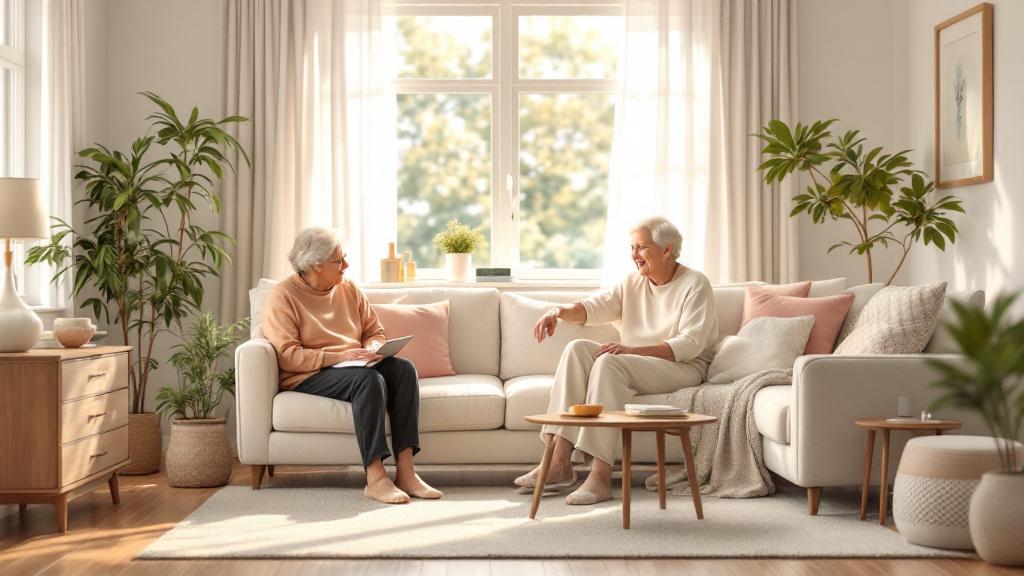The Importance of Regular Exercise for Nursing Home Residents
Unlocking Health and Vitality in Nursing Homes Through Exercise

Introduction
As we age, maintaining an active lifestyle becomes increasingly important, particularly for those residing in nursing homes. Regular exercise provides numerous benefits for the elderly, enhancing their quality of life and overall well-being. This article explores the importance of structured physical activity for nursing home residents and how it positively impacts various aspects of their lives.
Immediate and Long-term Health Benefits of Exercise

Physical Health Improvements
Regular exercise is vital for elderly people in nursing homes because it leads to significant physical health improvements. Engaging in activities like walking, strength training, or balance exercises can enhance mobility, strength, and flexibility. These factors are crucial for maintaining independence in daily activities. Furthermore, structured exercise programs have been shown to improve cardiovascular health, boost energy levels, and help manage chronic conditions such as arthritis and diabetes.
Prevention of Chronic Diseases
Consistent physical activity is an essential preventive measure against chronic diseases. Studies have indicated that regular exercise lowers the risk of serious conditions such as heart disease, hypertension, and diabetes. By incorporating a balanced routine that includes aerobic, strength, and flexibility exercises, nursing home residents can effectively manage their health. Such interventions not only contribute to longevity but also support better performance in activities of daily living (ADLs).
Mental Health Benefits
In addition to physical health improvements, exercise significantly enhances mental well-being among older adults. It decreases symptoms of anxiety and depression by releasing feel-good hormones like endorphins. Regular physical activity is also linked with improved cognitive function, reducing the risk of cognitive decline and dementia. Group exercise sessions create social interactions, which can alleviate loneliness and promote a sense of community, thereby enhancing mental health.
Overall, regular exercise in nursing homes fosters a healthier, more engaging lifestyle, improving the quality of life for residents.
The Multifaceted Benefits of Exercise for Nursing Home Residents

What are the specific benefits of regular exercise for nursing home residents?
Regular exercise for nursing home residents offers a range of significant benefits that contribute to their overall well-being. Here’s a closer look at those benefits:
Physical Health Improvements:
- Reduces the risk of chronic diseases such as diabetes, heart disease, and hypertension.
- Enhances cardiovascular fitness through activities such as brisk walking and swimming.
- Maintains muscle and bone strength with strength training and flexibility exercises, which are crucial for preventing falls and injuries.
Cognitive Health Benefits:
- Engaging in regular physical activity improves cognitive function and reduces the risk of cognitive decline and dementia.
- Improved memory, attention, and overall mental clarity are linked to consistent exercise routines.
Social Connections and Emotional Well-Being:
- Exercise fosters social interaction through group activities, which helps alleviate feelings of loneliness and isolation among residents.
- Regular physical activity reduces anxiety and depression by releasing endorphins, enhancing mood and providing emotional boosts.
Improved Sleep Quality:
- Regular exercise contributes to better sleep, helping residents fall asleep faster and sleep more soundly, which is vital for overall health.
Promoting Independence:
- By improving mobility and strength, exercise allows residents to perform daily activities independently longer, thereby enhancing their quality of life.
Overall, engaging in daily physical activities fosters social interaction among residents, enhancing their quality of life and supporting their independence.
Enhancing Quality of Life through Regular Physical Activity

How Can Exercise Impact the Quality of Life for Elderly Residents in Nursing Homes?
Exercise plays a vital role in improving the quality of life for elderly residents in nursing homes. Regular physical activity can lead to a multitude of benefits:
- Physical Fitness: Engaging in 150 to 300 minutes of moderate-intensity exercise weekly can enhance cardiovascular health and strengthen muscles and bones.
- Mental Well-Being: It has been shown to alleviate feelings of depression, improve mood, and enhance sleep quality. Endorphins released during exercise help combat anxiety.
- Social Interactions: Group activities promote social connections, reducing feelings of isolation and loneliness among residents.
Additionally, exercise can help manage age-related conditions. Activities that incorporate flexibility and balance training can significantly reduce the risk of falls, which is often a concern for older adults. Regular exercise routines empower residents to maintain independence and improve their overall functional abilities.
Exercise Guidelines and Recommendations
To reap the profound benefits of exercise, it's recommended that older adults incorporate a balanced routine that includes:
- Aerobic Activities: Such as walking, swimming, and cycling; these help with heart health.
- Strength Training: Using light weights or resistance bands to build muscle.
- Flexibility Exercises: Including yoga and stretching for overall well-being.
- Balance Exercises: Such as Tai Chi to prevent falls.
Utilizing goal-setting, finding exercise partners, and maintaining a training diary can enhance motivation for residents. By embracing a structured exercise program, nursing home residents can achieve a healthier lifestyle, reduce the risk of chronic diseases, and enhance their quality of life.
Structured Exercise Programs and Their Role in Prevention
Fall Prevention
Regular structured exercise programs play a crucial role in reducing fall risks among older adults in nursing homes. Activities such as balance training and resistance exercises are specifically designed to improve stability and coordination, which are essential for preventing falls. These exercise regimens help to enhance muscle strength and flexibility, significantly lowering the chances of injuries related to falls.
Muscle Strengthening and Balance
Muscle strengthening is another pivotal focus of these programs. Engaging residents in activities that promote strength not only helps maintain their physical independence but also supports their overall health. For instance, combined exercises that include both strength and balance training have shown to effectively improve mobility and reduce frailty among seniors. By adhering to a regular regimen, residents can experience enhanced muscle endurance and joint health, crucial for their everyday activities.
Tailored Exercise Interventions
Tailored exercise interventions are essential for maximizing the benefits of physical activity among nursing home residents. These programs take into account individual health conditions, abilities, and preferences, making it more likely that residents will engage and enjoy the activities. Incorporating a variety of exercises—such as strength training, balance exercises, and aerobic activities—ensures that all aspects of physical fitness are addressed, leading to holistic improvements in the quality of life for older adults.
Overcoming Barriers to Physical Activity

Common challenges and solutions
Older adults often face several barriers to maintaining an active lifestyle. These challenges include limited mobility, chronic health conditions, fear of falling, lack of motivation, and insufficient social support. To combat these issues:
- Encourage tailored exercises: Implementing exercise programs that accommodate individual physical capabilities can promote participation.
- Enhance motivation: Setting personal goals and celebrating small victories can inspire seniors to stay active.
- Safety measures: Creating safe environments for physical activities can alleviate fears of falling.
Role of community-based support
Community organizations play a crucial role in facilitating physical activity for older adults. They can:
- Offer tailored programs: Activities like walking groups, water aerobics, and gentle yoga can be tailored to suit various ability levels.
- Foster social connections: Group activities help reduce isolation, making physical activity a social event, which can significantly enhance participation.
- Provide resources: Support in terms of transportation to activity centers or accessing equipment can further minimize barriers to exercise.
By addressing these barriers and utilizing community support, older adults can enhance their physical activity levels, leading to improved overall health and well-being.
Social Benefits of Group Exercise

Reducing isolation and loneliness
Engaging in group exercise offers substantial social benefits for older adults, particularly in nursing homes. By participating in regular physical activities together, residents are provided with opportunities to interact, share experiences, and form friendships. These connections can significantly alleviate feelings of isolation and loneliness, which are often prevalent in this demographic. Effective group activities not only encourage social interaction but also foster a sense of community and belonging among participants, positively impacting their mental health.
Building community bonds
Moreover, group exercise sessions help strengthen community bonds within assisted living facilities. Residents participating in these sessions are likely to collaborate and encourage each other, enhancing peer support. As they work towards common physical health goals, these shared experiences create camaraderie and diminish feelings of anxiety and distress. Over time, this helps establish a thriving social network, significantly improving the overall quality of life for seniors.
| Social Benefits | Impact on Residents | Examples of Activities |
|---|---|---|
| Reduces loneliness | Enhances mood and emotional well-being | Group walking, dancing classes |
| Strengthens bonds | Fosters friendships and peer support | Seated exercise groups, yoga |
| Increases participation | Promotes engagement and regular attendance | Mini golf tournaments |
Cognitive and Emotional Boost from Staying Active
Cognitive Enhancements
Engaging in regular physical activity significantly boosts cognitive function in older adults. Exercise increases blood flow to the brain, which promotes the growth of new neurons. This neural growth can improve memory, attention, and lower the risk of cognitive decline and dementia, particularly helpful for those already experiencing impairments.
Emotional Well-Being and Mood
Regular exercise is a powerful tool for enhancing emotional health. It releases endorphins, which help alleviate symptoms of depression and anxiety, fostering a more positive outlook. Group activities, in particular, can enrich social connections among seniors, combating feelings of loneliness and isolation.
Additionally, exercise can lead to improved sleep quality, further contributing to overall mental well-being and reducing stress levels.
Exercise Recommendations
Experts recommend that older adults engage in a balanced routine comprising:
- Aerobic Activities: Walking, swimming, or cycling for cardiovascular health.
- Strength Training: Using resistance bands or light weights to maintain muscle mass.
- Flexibility Exercises: Incorporating yoga and stretching for greater agility.
- Balance Exercises: Such as Tai Chi to reduce fall risk.
Targeting 150 minutes of moderate-intensity activity per week ensures a comprehensive approach to maintaining both cognitive and emotional health.
Conclusion
Regular exercise stands as a cornerstone for enhancing the lives of nursing home residents. By fostering physical, mental, and social well-being, exercise programs tailored for older adults in long-term care settings can significantly improve their health outcomes and quality of life. Encouraging an active lifestyle and overcoming common barriers can empower these individuals to live healthier, more fulfilled lives while minimizing health risks and sustaining independence.
References
- Exercise and Social Activity Improve Everyday Function in Long ...
- [Benefits of physical activity in nursing home residents] - PubMed
- How Exercise Promotes Overall Well-Being for LTC Residents | Welbi
- The Role of Exercise in Elderly Health
- The Importance Of Physical Activity For Care Home Residents
- The Role of Exercise Programs in Assisted Living - Wellington Estates
- Comparison of the physical fitness levels in nursing home residents ...

How to Plan for Long-Term Home Care Services

How Home Team Helps Families Make Informed Care Decisions

How Home Team's Caregivers Provide Peace of Mind for Families



